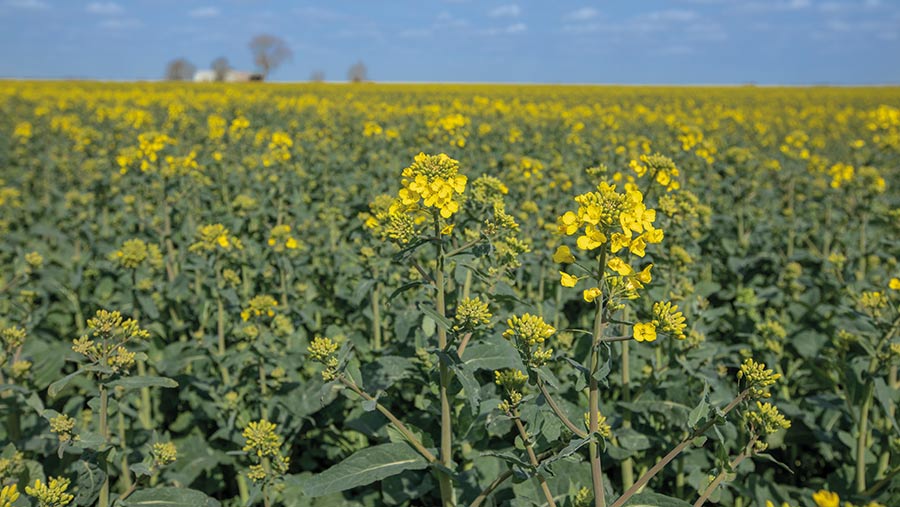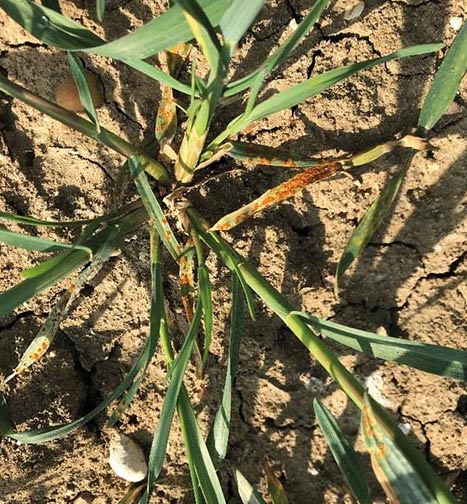Crop Watch: Frosts return as OSR starts to flower
 © Gary Naylor
© Gary Naylor A return of more wintery conditions has put the brakes on crop growth, with some OSR crops starting to flower as the frosts return.
Wheat crops are approaching their T1 timing and with plenty of disease bubbling away, agronomists are considering their fungicide options to keep on top of it once warmer conditions return.
See also: Can microbials replace chemicals for crop protection?
West
Stephen Harrison
AICC/Southwest Agronomy (Avon)
April, the first real spring month, is now with us, and it doesn’t feel very springlike at the moment. Crops look like the weather is playing tricks with them.
At the end of March, long sunny days were replaced by cold winds and sharp frosts. Winter OSR is creeping into flower, although crops on land with no history of OSR and high available nitrogen look very yellow.
A few pollen beetles have been seen, but nowhere near enough to justify treatment. High rapeseed prices are not justification for applying unjustified insecticides.
The same argument applies to winter beans, which are flourishing despite sitona weevil damage.
Current applications will make the bruchid beetle damage worse later in the season, as predator populations will take a knock from which recovery will not be possible this season.
The soaring price of nitrogen has resulted in many more fields receiving slurry in the growing crop, either by umbilical systems or tankers with booms and trailing shoes.
Spring break crops are having pig slurry injected pre-drilling, which will maximise manure N use efficiency.
Winter barley
Winter barley growth stages vary from late tillering in later-sown conventional varieties to GS 33 in hybrids established in early October.
Careful design of PGR programmes to accommodate this variation has been essential.
The most forward fields will shortly need ethephon-based products after a chlormequat/prohexadione or trinexapac GS 30 treatment while those still tillering will only have chlormequat.
GS 30 treatments have controlled brown rust infections.
The field of runners in the winter wheat “race to maturity” is well scattered. Extase is the clear front-runner – most fields of this variety are at GS 31 with only November-drilled crops after maize not there yet.
Adequate growth regulation is essential in this variety and care must be taken to ensure that products selected have activity at cooler temperatures.
Chlormequat alone can require up to 60 hours to take up 70% of a dose.
Spring barley drilling is virtually complete, and the first fields are at leaf one. A couple of fields of spring barley after grass (for rotational reasons) have been flat rolled to limit soil pest damage.
We await the results with some trepidation.
North
Helen Dent
Carbon Metrics (Cumbria)
March tricked us with a week of high temperatures and beautiful sunshine.
However, the weather has retreated to very cold nights and chilly days – which we are much more accustomed to in the North.
Where winter cereals had high disease pressure, a T0 fungicide has been applied alongside a plant growth regulator. In general, winter herbicide applications have done an excellent job.
However, the usual groundsel seems to have slipped through and where spring weeds are abundant, a spring herbicide has been applied, plus wild oat sprays where necessary.
Recent frosty nights have slowed down growth slightly.
Brown rust has been found in many winter barleys and, after walking through some of the hybrids, my boots were a beautiful shade of orange.
However, net blotch and rhynchosporium are the key concerns and targets of winter barley T1 applications.
Winter wheats are widely varied in growth stage, with early sown crops of Extase being very far forward and looking exceptionally tall.
Although it has been a reasonably dry weather, the mild winter means septoria is present in most crops on older leaves, and it is important to consider protection for the new leaves at T1 timing.
Green bud
Oilseed rape is around the green-bud stage, with some crops approaching flowering. Crops in general are strong and well tillered.
Crops should be monitored for pollen beetle, with this being the most susceptible timing. However, in general they are well below the threshold for spraying.
Also remember that as soon as the crop begins to flower, the pollen beetle turns from foe to friend overnight.
Grassland has picked up over the past month with rising soil temperatures, but the latest cold nights have knocked it back and growth has slowed.
The mild winter has contributed to lots of chickweed in grassland crops this spring. Remember that when using products such as fluroxypyr, warm, “growy” conditions are ideal for good levels of control.
South
Iain Richards
Agrii (Oxfordshire)
With temperatures varying by as much as 18C in a day, our crops have been under more than their fair share of stress lately.
A lot of sun and sharp easterly winds haven’t helped either, drying the ground out surprisingly rapidly after the early rain at a time when lengthening days are telling the plants they need to be moving upwards.
Getting a good early dressing of nitrogen on before the weather turned dry has been invaluable here; especially for OSR needing to grow away from some truly horrendous pigeon damage in places.
For the most part, plant populations are spot on. But we can only hope the early fertilisation and recent stem extension sprays have done enough to stop crops bolting.
Noticeably colder weather going into April is slowing things down. We just need some welcome rain now to allow them to access their second dose of nitrogen.
We’ve also done as much as we can to reduce spring stress on the OSR by including foliar magnesium, molybdenum and boron at stem extension to address early imbalances, which could easily have much more serious implications than usual this season.
Stress management has been central to our wheat agronomy, too, and a delicate balancing act.
On the one hand, many crops have been in particular need of early growth regulation, and we are very conscious of the heightened septoria risk to thick stands following a non-existent winter – especially with earlier sowings and after a significant early rain splash.
On the other hand, though, we dare not stress them with too much in the T0 tank.
Spring weeds
To avoid this, we have deliberately separated our spring weed clean-up from the spray. Where grassweeds were concerning we went in ahead of T0, which is the best timing to deal with them anyway.
And, despite considerable broad-leaved weed populations in many cases, we are holding off on controlling these until T1 wherever possible; not least because we fully expect more germination and don’t want to have to go in again.
Most of our T0 mixes are going on with foliar manganese and zinc to help crops use the nitrogen they’ve been able to access so far. And we are being very prescriptive about when to spray.
Even where there’s more than enough septoria in the base, it is far less risky to hold off for a while than go in just before a sharp frost.
Despite a marked lack of frost tilth to help after the winter covers were sprayed off, the vast majority of our spring barley, peas and beans have gone into good seed-beds.
Two inches of mid-March rain in four days, followed by rapid surface drying, left some ground surprisingly hard in places and needing a little loosening ahead of the drill.
It has also meant the earliest-sown barley on siltier land having to force its way through some troublesome capping.
So we fully expect crops that went in later in the month will catch them up in pretty short order.

Brown rust in barley © Becky Finbow
East
Becky Finbow
Agrovista (Norfolk/Suffolk)
Spring proceedings are currently on pause due to a flurry of snow.
Previously it had been all go, with cultivators, drills and sprayers rolling here in the east.
The warmer weather has allowed spring crops including sugar beet to be drilled into fine seed-beds and pre-emergences applied where necessary.
Sugar beet pre-emergence herbicides have been discussed due to the dry weather, but on inspection and after a bit of digging, there was still adequate moisture with more forecast to allow the chemistry to be activated.
Where blackgrass is apparent, a mixture of ethofumesate and metamitron has been recommended and where weed beet is an issue, Conviso Smart beet is being drilled, to be sprayed later with a single application of Conviso One (foramsulfuron + thiencarbazone).
Early-drilled winter wheats are now at GS30 and, depending on variety, may require a T0 fungicide.
Rusty varieties such as Zyatt and Wolverine will have a tebuconazole mix applied alongside a PGR, depending on crop size, plus some micronutrients to assist growth and maximise nitrogen use efficiency.
Yellow rust
Although these cold temperatures will interrupt the yellow rust cycle for now, when conditions become more favourable it will be vital to go in with a fungicide to halt its further spread.
Similarly, winter rye is now storming through the growth stages. In the east, brown rust is apparent in the crop.
Alongside fungicides for rust, PGR management is very important in rye to keep an already tall crop standing. I have started my programme with trinexapac-ethyl and some chlormequat.
Both actives work by inhibiting the production of growth hormones and hence produce thicker, stronger stems.
If necessary, an application of Terpal (ethephon + mepiquat) will be used before growth stage 39, flag leaf ligule just visible.
Winter barleys are now starting to be walked for weeds in preparation for T1 applications. Diseases such as rhynchosporium and brown rust are being seen, as well as common weeds such as poppy and groundsel.
Sulfonylureas should provide control, as long as the weeds are not too big or resistant.
For acetolactate synthase (ALS) inhibitor herbicide resistant poppies, Arylex (halauxifen) chemistry is recommended.

